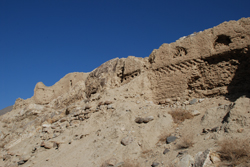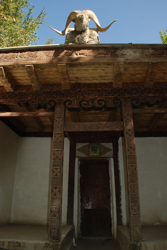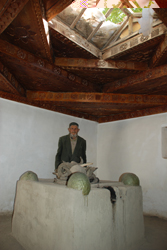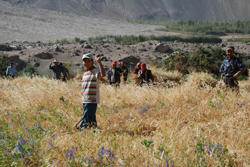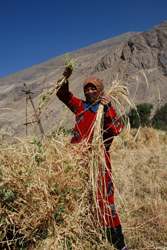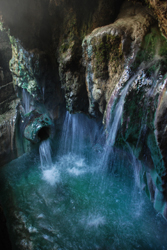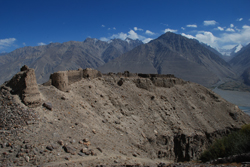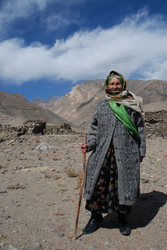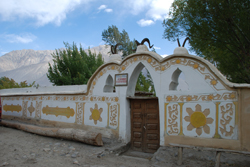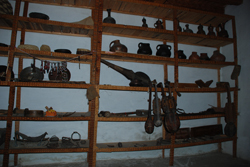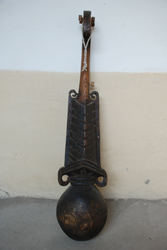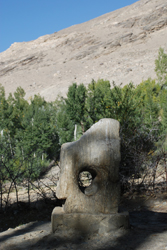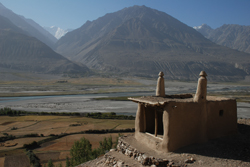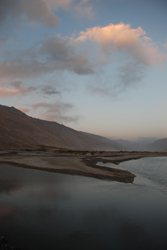Wakhan Trip Day 3: Spas, Stories and Sufis
21 September, 2008, 04:21 pm in "Tajikistan"
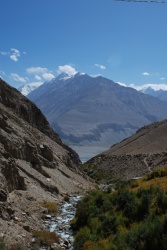 The Khakha fortress ruins are perched on a rocky outcropping. From the road you see a few low stone walls with a melting coat of mud covering some. We followed a path up into the ruins. The walls surrounded a good amount of space. In one corner there were the remains of a round tower. Walking up to a higher level we could see a view of the river and mountains as well as a line of more intact walls.
The Khakha fortress ruins are perched on a rocky outcropping. From the road you see a few low stone walls with a melting coat of mud covering some. We followed a path up into the ruins. The walls surrounded a good amount of space. In one corner there were the remains of a round tower. Walking up to a higher level we could see a view of the river and mountains as well as a line of more intact walls.A little farther down the road was a shrine to Ali, the Prophet Muhammed's cousin and brother-in-law. The shrine was behind a wall with a beautifully carved door and room and ibex horns decorating the wall above it. We entered the area. Though the yard was large and full of trees, the shrine itself was small. The exterior had more beautiful carvings: columns, ceiling, and door. Above it there was a mountain goat head.
As we were looking at the shrine, a man named Aminbek, the custodian of the tomb, entered. He opened the shrine door and invited us in. Inside there was a simple stone block with 4 green painted stones set in the corners and one in the center with a pile of horns. Aminbek told us a local legend that Ali came to Khakha in the Wakhan Valley to fight the Mongols. There was a contest of strength and he juggled 5 heavy stones and then changed his horses shoes while galloping. After that he started wrestling with the enemy. They were defeated by his strength. Later, I found a more historical account of Islam coming to the Pamirs. It actually came much later, after the deaths of Ali and his sons. In looking at the tomb with its carvings of flowers, animal horns, rocks and setting surrounded by trees, it struck me how the Pamir Ismaeli version of Islam seems a a bit pagan in aesthetics. It makes me think of how Christianity blended with ancient beliefs of people in converted places leading to instances like in Haiti where the gods and goddesses were transformed into incarnations of Mary and the Saints. I wonder if at one point the shrine was an older sacred site.
There was a museum next to the tomb but it was closed and looked like it was under repair. Aminbek said they could send someone down the street to get the key but we decided to skip it. A little farther we stopped to take a look at another fortress ruins. We didn't go all the way up to it but to get a closer look we crossed through a field where people were busy harvesting wheat. After looking at the fortress, we went up to the group and said hi. We found out that one of the men harvesting was the director of the museum. He recommended some places for us to visit.
In a golden field near the road, a group of women wearing rose, red, and purple dresses were busy harvesting grain using small scythes. They mentioned a phrase we have often heard here: the harvest isn't good because there hasn't been enough rain.
In a golden field near the road, a group of women wearing rose, red, and purple dresses were busy harvesting grain using small scythes. They mentioned a phrase we have often heard here: the harvest isn't good because there hasn't been enough rain.
Outside the carefully cultivated villages, the landscape was stark: rocks and a perpetual haze of dust. The only brightness was when the pure white of the snow glistened on the massive peaks which shone from between the closer mountains. The Hindu Kush seemed to present a new glistening peak every few minutes of road. Some had scraps of clouds caught on their peaks. Others were cloudless but completely snow covered.
By this time the river had spread out into a braided rope with sand and mud flat islands between its skeins. There were some areas of dark green trees.
We turned up a gravel road into the hills to get to Yamchun fortress and the Bibi Fatima springs. I'm generally not a big fan of hot springs: hot sulfury smelly water, pumped into grimy pools or muddy smelly pits. The pools have ½ hour for women and then ½ hour for men.
I was very surprised to find a beautiful natural pool with green and white mineral formations. Gentle cascades of hot water spilled into the pool and there was no stinky sulfur smell. There was a group of women, girls, and one little boy in the pool. As I went into the pool a girl began talking to me in English. She guided me into the pool and sat me next to where some water was flowing in through a mineral formation. Light filtered from above and it was really quite enjoyable. She showed me a small cave in the rocks full of hot water and told me to make a wish and crawl in. I scraped my elbow as I crawled out.
By this time the river had spread out into a braided rope with sand and mud flat islands between its skeins. There were some areas of dark green trees.
We turned up a gravel road into the hills to get to Yamchun fortress and the Bibi Fatima springs. I'm generally not a big fan of hot springs: hot sulfury smelly water, pumped into grimy pools or muddy smelly pits. The pools have ½ hour for women and then ½ hour for men.
I was very surprised to find a beautiful natural pool with green and white mineral formations. Gentle cascades of hot water spilled into the pool and there was no stinky sulfur smell. There was a group of women, girls, and one little boy in the pool. As I went into the pool a girl began talking to me in English. She guided me into the pool and sat me next to where some water was flowing in through a mineral formation. Light filtered from above and it was really quite enjoyable. She showed me a small cave in the rocks full of hot water and told me to make a wish and crawl in. I scraped my elbow as I crawled out.
When the guys were finished, we drove back to the fortress. The fortress was a bit better preserved than the others we'd seen, probably because the stone walls had been built so thick-- some seemed more than 4 ft thick. The fortress commanded a view of Afghanistan mountains, the river, and villages below. Zaher pointed out some yurts: white dots on the Afghan side at the edge of a landslide. He said they were archaeologists who were excavating a village that had been buried by the landslide.
Our final stop of the day ended up being the village of Yamg which is a stop because it was the home of Sufi poet, musician, astronomer and mystic Mubarek i-Wakhani. We walked through town searching for the Mubarek i-Wakhani Museum, and found a building with its walls decorated with painted designs. Inside, we found some more buildings, all ornately decorated but with locked doors. One of the people outside the museum ran off to get someone with keys. Soon the director, Haydar, showed up and gave us a tour of the museum.
The first thing we saw was called a chilehane. It was a small windowless building where Sufis could go and spend 40 days just writing. It was a reconstruction. The chilehanes Mubarak Whakani used were often out in nature.
(Later I was able to look at a book written by Iloliev, about Mubarek's life as well as the spread of Ismaili Islam in the Pamirs so most of the historical information I'm mentioning comes from that.)
The museum is in a Parmir house, beautifully carved and painted inside. It isn't the original house of Mubarek though I believe it is in the same location. It took 7 years to finish and many people of the village worked on it.
The first thing we saw was called a chilehane. It was a small windowless building where Sufis could go and spend 40 days just writing. It was a reconstruction. The chilehanes Mubarak Whakani used were often out in nature.
(Later I was able to look at a book written by Iloliev, about Mubarek's life as well as the spread of Ismaili Islam in the Pamirs so most of the historical information I'm mentioning comes from that.)
The museum is in a Parmir house, beautifully carved and painted inside. It isn't the original house of Mubarek though I believe it is in the same location. It took 7 years to finish and many people of the village worked on it.
The first room contained ethnographic everyday items like those that would have been used by Mubarek to make his own clothing, paper, carved wood and other practical items. These had been donated by people in the village as well.
There were some interesting rababs which were copies of a type of rabab invented by Mubarek called the “Baland-maqam” (highest state) which Mubarak played when meditating on what he felt were highest thoughts. It has 19 strings and Haydar later explained the significance of its construction: the body is made from apricot wood cut in spring when it was in flower because they say the tears of the apricot tree become the flower. Also it is thought that the flower sees the world since it is the young stage. The fruit is the final stage and has experience like a mature human. The strings are made from the gut of a lamb so when you play, you hear the sadness and cries of the lamb. The skin is from a foal so when you play, you hear the cries of the foal. The instrument from the back, resembles a human with head, arms, body and feet. The philosophy is that when you play, the cries of your heart and soul become music.
Outside in a field behind the museum is the solar calendar. It consisted of a stone with a round hole in it called the Observation stone (Sang-i-aftab-bin), through which you looked and observed where the sun set in relation to a stone window on the hill above and to the West, the Sign Post Stone (Sang-i-Nishan). On Nowruz, the first day of spring, a crescent of the sun could be seen through the signpost stone. If a full circle was seen, it was foretold. The year would be good. There were 2 stone pillars on the hill which were used in case of clouds on Nowruz. Then measurements could be taken using the pillar stones the day before and day after. Mubarek's tomb is near the signpost stones and with 2 stone pillars on top looks like it could be some kind of astronomical observation tool itself.
We decided to spend the night in Yamg and Haydar said tourists usually stay at his house. He took us to his house and we were delighted to see the table was already set with plates holding tomatoes and onions, bread, tea, and snacks. When he was told there were visitors at the museum, he had his family get tea ready for us. We were all famished since we hadn't stopped for lunch. We were served tea and then he asked if we wanted dinner which was also already prepared. We had a fine meal of soup and fried potatoes, onions and carrots.
As the sun set the wind picked up rushing through the valley and wailing over the roof of the house.
As the sun set the wind picked up rushing through the valley and wailing over the roof of the house.
[ View 1 Comments
|
]
Comments
michelle tavakoli -
posted on 3/23/2009
HOW FACINATING! WHAT A ROUNDED SCHOLAR U R!


